
Adolf Hitler, chancellor and dictator of Germany from 1933 to 1945, committed suicide via gunshot on 30 April 1945 in the Führerbunker in Berlin after it became clear that Germany would lose the Battle of Berlin, which led to the end of World War II in Europe. Eva Braun, his wife of one day, also committed suicide by cyanide poisoning. In accordance with Hitler's prior written and verbal instructions, that afternoon their remains were carried up the stairs and through the bunker's emergency exit to the Reich Chancellery garden, where they were doused in petrol and burned. The news of Hitler's death was announced on German radio the next day, 1 May.

Blondi was Adolf Hitler's German Shepherd, a gift as a puppy from Martin Bormann in 1941. Hitler kept Blondi even after his move into the Führerbunker located underneath the garden of the Reich Chancellery on 16 January 1945.
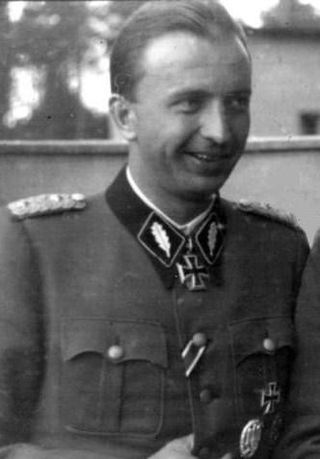
Hans Otto Georg Hermann Fegelein was a high-ranking commander in the Waffen-SS of Nazi Germany. He was a member of Adolf Hitler's entourage and brother-in-law to Eva Braun through his marriage to her sister Gretl.
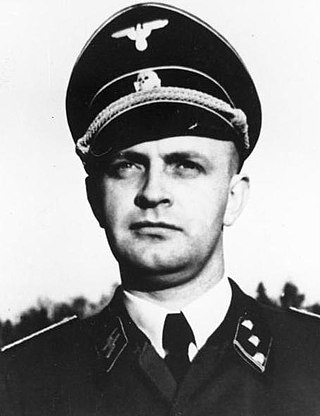
Heinz Linge was a German SS officer who served as a valet for the leader of Nazi Germany, Adolf Hitler, and became known for his close personal proximity to historical events. Linge was present in the Führerbunker on 30 April 1945, when Hitler committed suicide. Linge's ten-year service to Hitler ended at that time. In the aftermath of the Second World War in Europe, Linge spent ten years in Soviet captivity.
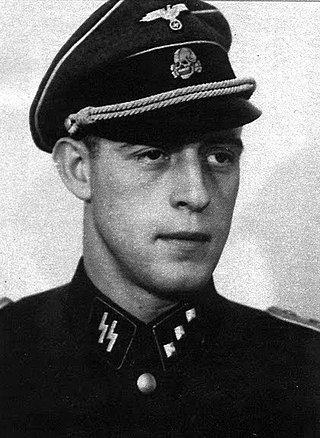
Otto Günsche was a mid-ranking officer in the Waffen-SS of Nazi Germany during World War II. He was a member of the SS Division Leibstandarte before he became Adolf Hitler's personal adjutant. Günsche was taken prisoner by soldiers of the Red Army in Berlin on 2 May 1945. After being held in various prisons and labour camps in the Soviet Union, he was released from Bautzen Penitentiary on 2 May 1956.

Wilhelm Brückner was Adolf Hitler's chief adjutant until October 1940. Thereafter, Brückner joined the Heer (army), becoming an Oberst (colonel) by war's end. He died on 18 August 1954 in then West Germany.
Wilhelm Zander was an adjutant to Martin Bormann during World War II. He died in Munich in 1974.
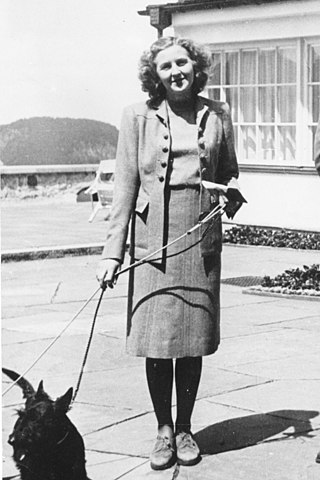
Eva Anna Paula Hitler was a German photographer who was the longtime companion and briefly the wife of Adolf Hitler. Braun met Hitler in Munich when she was a 17-year-old assistant and model for his personal photographer, Heinrich Hoffmann. She began seeing Hitler often about two years later.
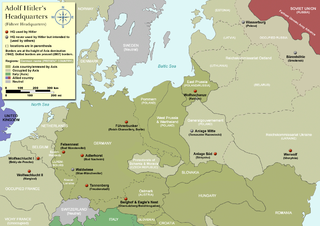
The Führer Headquarters, abbreviated FHQ, were a number of official headquarters used by the Nazi leader Adolf Hitler and various other German commanders and officials throughout Europe during World War II. The last one used, the Führerbunker in Berlin, where Hitler committed suicide on 30 April 1945, is the most widely known headquarter. Other notable headquarters are the Wolfsschanze in East Prussia, where Claus von Stauffenberg in league with other conspirators attempted to assassinate Hitler on 20 July 1944, and Hitler's private home, the Berghof, at Obersalzberg near Berchtesgaden, where he frequently met with prominent foreign and domestic officials.
Heinz Lorenz was German Chancellor Adolf Hitler's Deputy Chief Press Secretary during World War II.

Hugo Johannes Blaschke was a German dental surgeon notable for being Adolf Hitler's personal dentist from 1933 to April 1945 and for being the chief dentist on the staff of Reichsführer-SS Heinrich Himmler.
Fritz Tornow was a Feldwebel in the German Army who served as Adolf Hitler's personal dog-handler. He was one of the last people to occupy the Führerbunker when the underground complex was captured by Soviet Red Army troops.
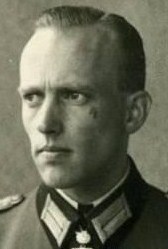
Willy Johannmeyer was a German officer during World War II who served from 1939 to 1945. He was also a recipient of the Knight's Cross of the Iron Cross with Oak Leaves, and at the time of the dissolution of Nazi Germany, the last adjutant to Adolf Hitler of the army (Heeresadjutant).
Giles MacDonogh is a British writer, historian and translator.

Benno Martin was a German SS functionary during the Nazi era. He served as Gestapo chief and Higher SS and Police Leader in Nuremberg. Martin was a member of the Nazi Party, joining in 1933.
Ewald Lindloff was a Waffen-SS officer during World War II, who was present in the Führerbunker on 30 April 1945, when Hitler committed suicide. He was placed in charge of disposing of Hitler's remains. Lindloff was later killed during the break-out on 2 May 1945 while crossing the Weidendammer Bridge under heavy fire in Berlin.
Gerhard Schach was a German politician, who was a member of the Preußischer Landtag and the Reichstag. He was present in the Berlin Führerbunker during the last days of Adolf Hitler in April 1945. Schach left the bunker complex on 1 May 1945.
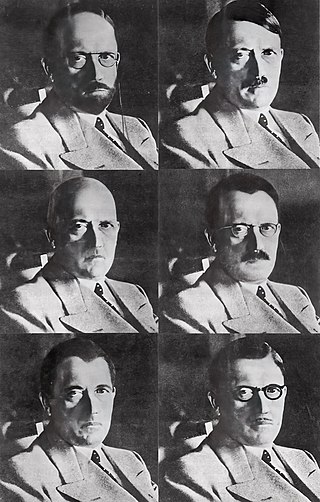
Conspiracy theories about the death of Adolf Hitler, dictator of Germany from 1933 to 1945, contradict the accepted fact that he committed suicide in the Führerbunker on 30 April 1945. Stemming from a campaign of Soviet disinformation, most of these theories hold that Hitler and his wife, Eva Braun, survived and escaped from Berlin, with some asserting that he went to South America. In the post-war years, the United States Federal Bureau of Investigation (FBI) and Central Intelligence Agency (CIA) investigated some of the reports, without lending them credence. The 2009 revelation that a skull in the Soviet archives long (dubiously) claimed to be Hitler's actually belonged to a woman has helped fuel conspiracy theories.
Henrik Eberle is a German historian. During the first decade of the twenty-first century he came to prominence beyond the confines of the German academic community with compilations, books, articles and interviews concerned with Adolf Hitler. Some of these have been translated into English.

The Death of Adolf Hitler: Unknown Documents from Soviet Archives is a 1968 book by Soviet journalist Lev Bezymenski, who served as an interpreter in the Battle of Berlin. The book gives details of the purported Soviet autopsies of Adolf Hitler, Eva Braun, Joseph and Magda Goebbels, their children, and General Hans Krebs. Each of these individuals are recorded as having been subjected to cyanide poisoning; contrary to the Western conclusion that Hitler died by a suicide gunshot.













